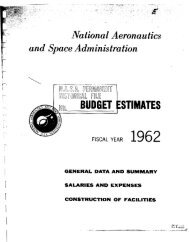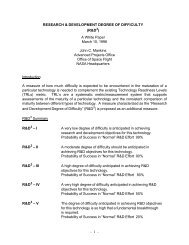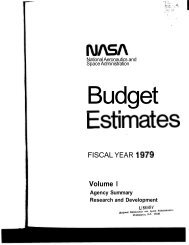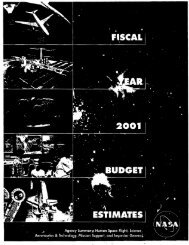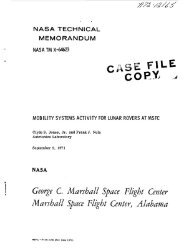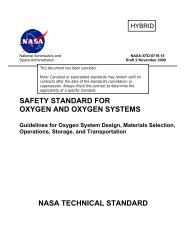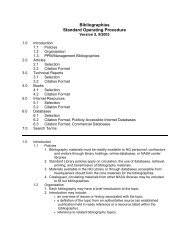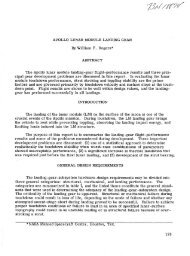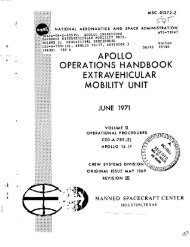crimping, interconnecting cables, harnesses, and wiring - NASA
crimping, interconnecting cables, harnesses, and wiring - NASA
crimping, interconnecting cables, harnesses, and wiring - NASA
You also want an ePaper? Increase the reach of your titles
YUMPU automatically turns print PDFs into web optimized ePapers that Google loves.
Page 35 of 114<br />
<strong>NASA</strong>-STD-8739.4 with Change 6<br />
7.3.5 Tin-plated parts (e.g., terminals, crimp barrels, etc.) must be fused or alloyed with tin-lead<br />
plating (Requirement).<br />
7.3.6 Methods of identifying <strong>cables</strong>, connectors, <strong>and</strong> wires <strong>and</strong> their effects on environmental<br />
requirements (Requirement).<br />
7.3.7 Radio frequency interference/electromagnetic interference (RFI/EMI) shielding<br />
requirements (Requirement).<br />
7.3.8 Operation of circuits through critical pressure (require that potentials in excess of 200 Vac<br />
or 300 Vdc be terminated in a single-contact, high voltage connector) (Requirement).<br />
7.3.9 Electrical <strong>wiring</strong> of redundant systems, redundant subsystems, or redundant major<br />
elements of subsystems shall not be routed in the same bundle or through the same connector<br />
with <strong>wiring</strong> of the other system, subsystem, or subsystem element (Requirement).<br />
7.3.10 Separate h<strong>and</strong>ling of radio frequency (RF) signals in coaxial cable <strong>and</strong> RF connector<br />
assemblies (Requirement).<br />
7.3.11 Materials <strong>and</strong> <strong>wiring</strong> design to meet <strong>NASA</strong>-STD-6001, Flammability, Odor, Offgassing<br />
<strong>and</strong> Compatibility Requirements <strong>and</strong> Test Procedures for Materials in Environments that Support<br />
Combustion (Requirement).<br />
7.3.12 American wire gage (AWG) 24 wire size <strong>and</strong> larger is preferred for conductors in<br />
<strong>interconnecting</strong> cable <strong>and</strong> harness assemblies, including coaxial or triaxial <strong>cables</strong> (Requirement).<br />
High strength copper alloy shall be used for AWG 24 <strong>and</strong> smaller conductors (Requirement).<br />
When high strength copper alloy wire is used, a magnetic survey of the installation shall be<br />
conducted if project requirements indicate a sensitivity to magnetic interference (Requirement).<br />
7.3.13 Torque values applicable for connectors, backshells, <strong>and</strong> other hardware (Requirement).<br />
7.3.14 Route <strong>and</strong> support <strong>harnesses</strong> <strong>and</strong> <strong>cables</strong> so that they are protected from abrasion, cold<br />
flow, cut through, vibration, chafing, flexing, <strong>and</strong> sharp edges (Requirement).<br />
7.3.15 Design minimization of splicing (Requirement).<br />
7.3.16 Protection of all electrical terminations to withst<strong>and</strong> the operating environment<br />
(Requirement).<br />
7.3.17 Preconditioning using thermal cycling prior to preparation for connectorization in high<br />
frequency applications using semi-rigid coaxial cable (Requirement). This procedure should also<br />
be considered for longer runs of flexible coaxial cable.<br />
7.3.18 Confining line voltages to connectors with sockets to preclude exposing voltage points<br />
when connectors are disconnected (Requirement).<br />
7.3.19 Specifying the use of sealing plugs <strong>and</strong> unused contacts in environmental connectors<br />
(Requirement).<br />
7.3.20 Fabricate <strong>cables</strong> containing discrete wires in one or more layers by winding the wires<br />
together uniformly (Requirement). Whether successive layers are twisted contrahelically or<br />
unidirectionally is optional. Winding shall prevent the introduction of residual twist into



